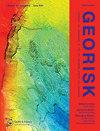PDEM-based seismic performance evaluation of circular tunnels under stochastic earthquake excitation
IF 4.8
3区 工程技术
Q1 ENGINEERING, GEOLOGICAL
Georisk-Assessment and Management of Risk for Engineered Systems and Geohazards
Pub Date : 2023-09-19
DOI:10.1080/17499518.2023.2257171
引用次数: 2
Abstract
ABSTRACTTunnels are a vital component of urban infrastructure that must be robust against seismic hazards. Given the randomness of earthquake occurrence, the seismic response of tunnel structures mut be studied by stochastic analysis methods. To this end, this study proposes a probability density evolution method (PDEM)-based framework to investigate the seismic performance of a circular tunnel under stochastic earthquake excitation. First, a suite of nonstationary earthquake motions compatible with the seismic design code was derived using a stochastic earthquake model. Then, a series of nonlinear dynamic numerical simulations were conducted for a typical circular tunnel that considers the soil-structure interaction. Finally, using the tunnel inclination angle as the performance index, the probability density function of the structural response of the tunnel was solved using the PDEM to obtain the corresponding exceedance probabilities of the tunnel under various damage states. The results show that the PDEM-based framework can be applied to evaluate the seismic performance of circular tunnels and could serve as a reference on the seismic fragility of tunnels and underground structures.KEYWORDS: Tunnelprobability density evolution methodstochastic dynamic responseexceedance probability Disclosure statementNo potential conflict of interest was reported by the author(s).Additional informationFundingThis research was supported by National Key Research and Development Program of China (grant number 2022YFC3800905), National Natural Science Foundation of China (Grants No. 52108381, 52238010, 52090082), Innovation Program of Shanghai Municipal Education Commission (grant number 2019-01-07-00-07-456 E00051), Shanghai Science and Technology Committee Program (Grants No. 22dz1201202, 21dz1200601, 20dz1201404, 22XD1430200), and Natural Science Foundation of Chongqing, China (No. CSTB2023NSCQ-MSX0808).基于pdem的随机地震作用下圆形隧道抗震性能评价
摘要隧道是城市基础设施的重要组成部分,必须能够抵御地震灾害。考虑到地震发生的随机性,隧道结构的地震反应必须采用随机分析方法进行研究。为此,本文提出了一种基于概率密度演化方法(PDEM)的框架来研究随机地震作用下圆形隧道的抗震性能。首先,利用随机地震模型推导出一套符合抗震设计规范的非平稳地震运动。然后,对考虑土-结构相互作用的典型圆形隧道进行了一系列非线性动力数值模拟。最后,以隧道倾角为性能指标,利用PDEM求解隧道结构响应的概率密度函数,得到隧道在不同损伤状态下的相应超越概率。结果表明,基于pdem的框架可用于圆形隧道的抗震性能评估,可为隧道及地下结构的地震易损性评估提供参考。关键词:隧道概率密度演化方法随机动态响应超越概率披露声明作者未报告潜在利益冲突。本研究得到国家重点研发计划项目(批准号:2022YFC3800905)、国家自然科学基金项目(批准号:52108381、52238010、52090082)、上海市教委创新计划项目(批准号:2019-01-07-00-07-456 E00051)、上海市科委项目(批准号:22dz1201202、21dz1200601、20dz1201404、22XD1430200)、重庆市自然科学基金的支持。中国(没有。CSTB2023NSCQ-MSX0808)。
本文章由计算机程序翻译,如有差异,请以英文原文为准。
求助全文
约1分钟内获得全文
求助全文
来源期刊
CiteScore
8.70
自引率
10.40%
发文量
31
期刊介绍:
Georisk covers many diversified but interlinked areas of active research and practice, such as geohazards (earthquakes, landslides, avalanches, rockfalls, tsunamis, etc.), safety of engineered systems (dams, buildings, offshore structures, lifelines, etc.), environmental risk, seismic risk, reliability-based design and code calibration, geostatistics, decision analyses, structural reliability, maintenance and life cycle performance, risk and vulnerability, hazard mapping, loss assessment (economic, social, environmental, etc.), GIS databases, remote sensing, and many other related disciplines. The underlying theme is that uncertainties associated with geomaterials (soils, rocks), geologic processes, and possible subsequent treatments, are usually large and complex and these uncertainties play an indispensable role in the risk assessment and management of engineered and natural systems. Significant theoretical and practical challenges remain on quantifying these uncertainties and developing defensible risk management methodologies that are acceptable to decision makers and stakeholders. Many opportunities to leverage on the rapid advancement in Bayesian analysis, machine learning, artificial intelligence, and other data-driven methods also exist, which can greatly enhance our decision-making abilities. The basic goal of this international peer-reviewed journal is to provide a multi-disciplinary scientific forum for cross fertilization of ideas between interested parties working on various aspects of georisk to advance the state-of-the-art and the state-of-the-practice.

 求助内容:
求助内容: 应助结果提醒方式:
应助结果提醒方式:


